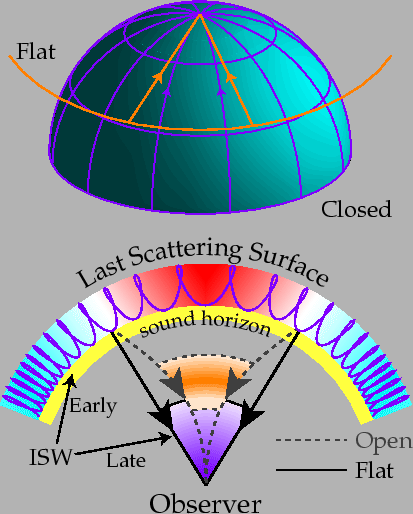The radiation of the cosmological diffuse bottom was emitted meadows of ![]() years after the Big-bang corresponds to the period when the temperature
became sufficiently low to make it possible the electrons to combine
with the protons to form the first atoms, then first molecules (in the
very great majority of hydrogen and helium). Previously, the universe
formed a plasma which was completely opaque with the radiation. The
universe thus became at that time transparency. The photons produced at
the time of the recombination thus could travel being observed since
then today. The fossil cosmological radiation represents a cosmological
mine of information. In particular, we will show in the continuation
how it could be used to force the cosmological parameters and in
particular the geometry of the universe.
years after the Big-bang corresponds to the period when the temperature
became sufficiently low to make it possible the electrons to combine
with the protons to form the first atoms, then first molecules (in the
very great majority of hydrogen and helium). Previously, the universe
formed a plasma which was completely opaque with the radiation. The
universe thus became at that time transparency. The photons produced at
the time of the recombination thus could travel being observed since
then today. The fossil cosmological radiation represents a cosmological
mine of information. In particular, we will show in the continuation
how it could be used to force the cosmological parameters and in
particular the geometry of the universe.
The CMB has anisotropies; they correspond to relative variations of temperature about ![]() . One can show that these variations are directly connected to the fluctuations of density at the time of the recombination.
. One can show that these variations are directly connected to the fluctuations of density at the time of the recombination.
It is the study of the variations of density which will make it possible to force cosmology.
Indeed, the fluctuations of density allow the collapse of the matter and the radiation in the formed wells of gravitational potentials, which involves an increase in temperature. Thus, a photon coming from a on-dense area will be hotter, while a photon coming from a less dense area will be colder.
In addition, the heating of gas increases the pressure of radiation of the photons and can cause a stop of the collapse followed by a dilation. There is appearance of oscillations.
These oscillations can be interpreted
like acoustic waves. The greatest scale reached by these waves is the
horizon of these sound waves which move at a speed ![]() .
The greatest amplitudes in the oscillations are thus a direct
measurement of the size of the horizon at the time of the
recombination.
.
The greatest amplitudes in the oscillations are thus a direct
measurement of the size of the horizon at the time of the
recombination.
As figure 1.4 shows it , the measurement of the angular size of an object which one knows dimension makes it possible to make a measurement of the geometry of the universe.
 |
The measurement of the fluctuations of temperature thus allows a direct measurement of the geometry. In practice, the amplitude of the fluctuations is given according to their angular scale on the sky. For that, one breaks up them on a basis of spherical harmonics:
 |
(1.23) |
Each multipolar moment ![]() which measure the importance of these fluctuations on a corresponding angular scale.
which measure the importance of these fluctuations on a corresponding angular scale.
In this representation, one can show that the first peak corresponds to the greatest amplitudes of temperature and thus of density (which corresponds to the horizon of the acoustic waves at the time of the recombination). The measure of location of this peak thus allows an estimate of the angular size of these fluctuations and thus of the geometry. The result of WMAP is (spergel2003):
| (1.24) |
Figure 1.5
exit of spergel2003 shows the measurement made by satellite WMAP. It in
particular made it possible to refine measurements of several embarked
experiments in balloon stratospheric (Boomerang and MAXIMUM, jaffe2001
or Archeops, Benoit2003), while measuring ![]() with a very high degree of accuracy, it made it possible to show that the universe was almost flat.
with a very high degree of accuracy, it made it possible to show that the universe was almost flat.
We will see in the continuation that the study of the other peaks of the spectrum of ![]() allows the measurement of other cosmological parameters.
allows the measurement of other cosmological parameters.